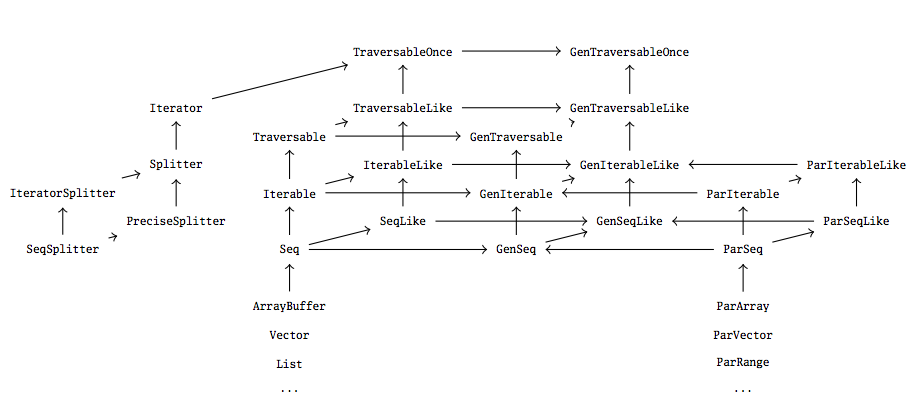Like the normal, sequential collections library, Scala’s parallel collections library contains a large number of collection operations which exist uniformly on many different parallel collection implementations. And like the sequential collections library, Scala’s parallel collections library seeks to prevent code duplication by likewise implementing most operations in terms of parallel collection “templates” which need only be defined once and can be flexibly inherited by many different parallel collection implementations.
The benefits of this approach are greatly eased maintenance and extensibility. In the case of maintenance– by having a single implementation of a parallel collections operation inherited by all parallel collections, maintenance becomes easier and more robust; bug fixes propagate down the class hierarchy, rather than needing implementations to be duplicated. For the same reasons, the entire library becomes easier to extend– new collection classes can simply inherit most of their operations.
Core Abstractions
The aforementioned “template” traits implement most parallel operations in
terms of two core abstractions– Splitters and Combiners.
Splitters
The job of a Splitter, as its name suggests, is to split a parallel
collection into a non-trivial partition of its elements. The basic idea is to
split the collection into smaller parts until they are small enough to be
operated on sequentially.
trait Splitter[T] extends Iterator[T] {
def split: Seq[Splitter[T]]
}
Interestingly, Splitters are implemented as Iterators, meaning that apart
from splitting, they are also used by the framework to traverse a parallel
collection (that is, they inherit standard methods on Iterators such as
next and hasNext.) What’s unique about this “splitting iterator” is that,
its split method splits this (again, a Splitter, a type of Iterator)
further into additional Splitters which each traverse over disjoint
subsets of elements of the whole parallel collection. And similar to normal
Iterators, a Splitter is invalidated after its split method is invoked.
In general, collections are partitioned using Splitters into subsets of
roughly the same size. In cases where more arbitrarily-sized partitions are
required, in particular on parallel sequences, a PreciseSplitter is used,
which inherits Splitter and additionally implements a precise split method,
psplit.
Combiners
Combiners can be thought of as a generalized Builder, from Scala’s sequential
collections library. Each parallel collection provides a separate Combiner,
in the same way that each sequential collection provides a Builder.
While in the case of sequential collections, elements can be added to a
Builder, and a collection can be produced by invoking the result method,
in the case of parallel collections, a Combiner has a method called
combine which takes another Combiner and produces a new Combiner that
contains the union of both’s elements. After combine has been invoked, both
Combiners become invalidated.
trait Combiner[Elem, To] extends Builder[Elem, To] {
def combine(other: Combiner[Elem, To]): Combiner[Elem, To]
}
The two type parameters Elem and To above simply denote the element type
and the type of the resulting collection, respectively.
Note: Given two Combiners, c1 and c2 where c1 eq c2 is true
(meaning they’re the same Combiner), invoking c1.combine(c2) always does
nothing and simply returns the receiving Combiner, c1.
Hierarchy
Scala’s parallel collection’s draws much inspiration from the design of Scala’s (sequential) collections library– as a matter of fact, it mirrors the regular collections framework’s corresponding traits, as shown below.
The goal is of course to integrate parallel collections as tightly as possible with sequential collections, to allow for straightforward substitution of sequential and parallel collections.
In order to be able to have a reference to a collection which may be either
sequential or parallel (such that it’s possible to “toggle” between a parallel
collection and a sequential collection by invoking par and seq,
respectively), there has to exist a common supertype of both collection types.
This is the origin of the “general” traits shown above, GenTraversable,
GenIterable, GenSeq, GenMap and GenSet, which don’t guarantee in-order
or one-at-a-time traversal. Corresponding sequential or parallel traits
inherit from these. For example, a ParSeq and Seq are both subtypes of a
general sequence GenSeq, but they are in no inheritance relationship with
respect to each other.
For a more detailed discussion of hierarchy shared between sequential and parallel collections, see the technical report. [1]
